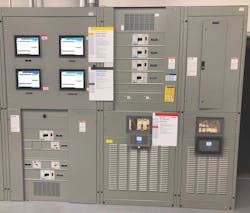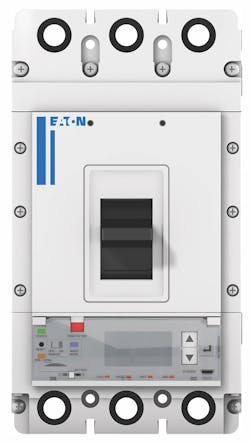About the author:
Rob Griffin is global product line manager of molded case circuit breakers for Eaton. Griffin can be reached at [email protected].
Internet of Things (IoT) technologies have emerged as a more efficient means of monitoring water systems. Now, the same principles are being applied to intelligent circuit breakers. These modern solutions embed protection, energy metering, intelligence and connectivity in a foundational electrical system component to go beyond traditional circuit protection. Now, there is an opportunity for deeper power system visibility and advanced predictive diagnostics. WWD spoke with Rob Griffin, global product line manager at Eaton, to learn how the company’s Power Defense molded case circuit breaker technology is modernizing facility management.
WWD: When it comes to circuit protection, what standards apply?
Rob Griffin: Industry authorities provide guidelines for evaluating and improving electrical systems and safety practices. When it comes to applying circuit protection in water and wastewater systems, there are a host of important standards, including those put forth by the Occupational Safety and Health Administration (OSHA), Institute of Electrical and Electronics Engineers (IEEE), National Fire Protection Assn. (NFPA) and National Electrical Code (NEC).
In regard to specific circuit protection guidelines, OSHA enforces safety practices based on NFPA 70 and 70E, which help protect people and property from electrical hazards. NFPA 70 and 70E are the standards for safe electrical design, installation and inspection and address electrical safety work practices. Equally important, the NEC Section 240.87 introduced in 2011 and since updated, also is intended to help protect electrical workers from arc flash hazards and enhance safety.
WWD: Is arc flash safety a concern?
Griffin: Exposure to an arc flash event is arguably one of the most critical safety issues in maintaining electrical systems. Based on data from the U.S. Bureau of Labor Statistics, these events impact personnel across all experience levels, which means every member of an organization needs to be aware of risk and knowledgeable of mitigation techniques.
There are inherent hazards associated with working on energized electrical equipment, and even inspecting electrical equipment can expose personnel to electrical shock and other dangers. To enhance safety, work on electrical systems should be performed when the systems are de-energized. Unfortunately, that’s simply not practical or possible for critical water industry processes, and the steps required to confirm that an electrical circuit is de-energized can put personnel at risk. Therefore, when work needs to occur on energized equipment, NFPA and NEC guidance on methods to reduce risk and enhance safety should be closely followed.
WWD: Can smart circuit breakers impact safety during maintenance?
Griffin: I want to emphasize again that the best way to work on electrical equipment is when it is de-energized. Yet, it is not always possible or practical in critical process environments.
It is important to start by looking at the relevant codes for guidance on safety. For example, the NFPA 70E recognizes both preventative and protective risk controls and
provides the following hierarchy: elimination, substitution, engineering controls, awareness, administrative controls and personal protective equipment.
You’ll also find there are three factors that impact the severity of an arcing event: power of the arc or available fault current, distance to the event and duration.
In (the) water industry (and other) applications, it is typically difficult to change the available fault current or the proximity of the unknown event to personnel. Yet, the duration of the event can be greatly reduced and here’s where Power Defense circuit breakers can help enhance safety because reducing the time of an arc event will significantly lower the incident energy.
Common techniques to shorten arc flash events and reduce fault-clearing times include zone selective interlocking (ZSI), which is designed to be active all the time, and energy reducing maintenance switches, like Eaton’s Arcflash Reduction Maintenance System technology, which shorten durations when enabled.
While both of these techniques can be used together to enhance safety, one of the biggest challenges with zone selective interlocking is the lack of visuals or other indications to confirm that method is engaged and active. New intelligent circuit breakers and electronic trip units show the function is enabled and provide confirmation to maintenance personnel that the system is connected and functioning.
Energy reducing maintenance switches like the Arcflash Maintenance System technology are dedicated, fast-acting systems used during maintenance operations when personnel need to work on energized electrical equipment, as allowed by the NFPA 70E Standard. This technology can bypass nonessential circuits within the electronic trip unit and save critical milliseconds, providing fast breaker clearing time and helping reduce arc energy exposure.
This technology needs to be activated either by personnel or automatically, for example via occupancy sensor. Once maintenance is complete, NFPA 70E lockout and tagout procedures should be followed for engaging and disengaging the energy reducing function, returning the circuit breaker to normal function.
Both zone selective interlocking and energy reducing maintenance switch technology have been well proven and studied. Today, they still have a critical role when it comes to electrical safety, especially with the development of Power Defense circuit breakers and Power Xpert Release electronic trip units that can provide visual indication and remote operation, so personnel have confidence the systems are working as intended.
WWD: How do communications and intelligence advance safety during maintenance?
Griffin: Here’s the upshot; communications and intelligence at the foundational electrical system level (in the circuit breaker) can make a transformational difference in electrical system maintenance to enable easier, faster and far more cost-effective operations. Intelligent circuit protection, like Power Defense technology, supports these benefits by providing critical, historical and real-time information for maintenance personnel including, which devices—if any—need to be serviced or replaced, in-depth circuit breaker health algorithms and visibility into where and why a fault occurred, making it easier and faster to restore power
Let’s take a step back and see why this is so important. Molded case circuit breakers provide vital functionality for low-voltage systems supporting water and wastewater processes. They provide a safe, economical way to protect connected equipment from overloads and short circuits. Because they are so effective and proven to be reliable, they are pervasive and hundreds of these circuit breakers can be used to support water industry processes.
For example, a facility with over 850 of these circuit breakers in operation took a closer look at its devices as part of a preventative maintenance plan. Of those 850-plus devices, five needed to be replaced, representing 0.57% of the total number of circuit breakers in the facility. This facility needed to schedule significant downtime for skilled maintenance personnel to physically check the operations of each of the 850-plus breakers. Even with that significant effort, they were only able to glimpse a moment in time, since these breakers could not deliver 24/7 performance data.
Now, intelligent circuit breakers can provide real-time data that can be tracked and analyzed to prompt condition-based maintenance, which is a much easier and more cost-effective way to maintain an electrical system than traditional approaches. Using the technology, maintenance personal can much more easily find the proverbial needle in a haystack. With data-driven insights, organizations can also increase equipment uptime and reduce the effort and costs involved in determining equipment that needs to be serviced.
WWD: Can smart circuit breakers impact safety during maintenance?
Griffin: In short, yes. Smart breakers can help enhance safety. For example, energy reducing maintenance switch technology, like the Arcflash Reduction Maintenance System, is designed to be used only during maintenance and can reduce arc energy by over 60%.
The system can be used in addition to other traditional solutions for arc flash energy reduction, further enhancing safety. This protection can shorten the duration of faults beyond the zone selective interlocking scheme or standard tripping function of the circuit breaker. Energy-reducing maintenance switch technology can deliver clearing times that are faster than the instantaneous setting on the breaker trip unit. The shorter duration reduces the level of arc fault energy available downstream, helping enhance safety.
Using energy-reducing maintenance switch technology in combination with zone selective interlocking provides important arc energy reduction during maintenance. Not only is the energy reduction an enhancement for safety, but it is an important factor for reducing the damaging effects to critical equipment.
Reducing the total clearing time goes a long way to reducing hazards. The means to accomplish this are evolving and manufacturers like Eaton are investing in the research and development to help make systems safer by design.
WWD: Are there other aspects of safety related to circuit protection that you’d
like to address?
Griffin: Arc quenching switchgear is an alternative that can provide a substantial reduction in incident energy. This technology can be used in conjunction with arc-reduction maintenance switch technology and zone-selective interlocking.
Arc-quenching equipment works an order of magnitude faster than traditional methodologies to clear faults in times as little as 4 milliseconds. This arc-quenching system is designed to be “always on” and does not require administrative controls to provide protection. The arc-quenching device eliminates the fault arc by providing an alternative current path until the upstream circuit breakers trip and open the circuit. Since the arc-quenching device creates a current-limited lower impedance path, it dramatically reduces the peak fault current when compared to a bolted fault solution.
Further, arc-quenching switchgear can reduce the incident energy to such a low level that it is able to provide ANSI/IEEE C37.20.7 arc-resistant protection without the need for ducts, plenums, venting into the room or special enclosure construction.

